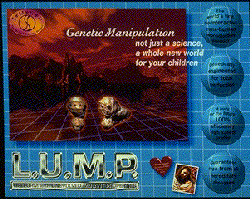| If you are not out for some social interaction in a
MUD or a MOO or other types of discussion groups in which
you basically function as a player, calling up a Web site
can generally be likened to a type of computerised
browsing in a virtual library. The user's objective;
information, entertainment or diversion, determines their
approach. Connections are text-based, so the user acts in
a mode of random-access reading, able to jump to any
portion of the stored information without having to read
any other first. Images are not seen but scrolled,
scanned or clicked on. The nexus between perception and
the construction of meaning relies on skimming the
surface, in an instantaneous desire to see, interpret and
know.
Recently deceased Australian artist Ian Burn
identified a contemporary disregard for the act of
seeing, calling it a shift away from perception,
"(a)way from using our looking as part of the
dialogue with a work of art, as a way of questioning the
object".1 Burn considered the phenomena of reading
pictures a rhetorical vision, which eliminates the
tension, contradiction and paradox between what we see
and what we know.
The computer screen engages new dialogues with the
viewer and between artist and audience. What are these
new relationships and do they reduce the subject’s
range of experience to purveying abstract information?
Our embrace of computer technology and the determinist
standpoint adopted by sections of western governments,
media and business require attempts to recognise the
cultural impact of this industry. How does reality
compare to the rhetoric and fashionable metaphors
associated with digital technology? What changes do we
have to make to accommodate these new forms of
communication (digital photography, networks, multimedia)
and do they make a difference? Are computerised
communications altering concepts of presence, place and
time? Who is being empowered by these tools and are they
being used to address the social, cultural and artistic
ramifications of living in an age of the
"information autobahn" (whatever that might
be)?
Footnotes
1. Burn, I., Looking at Seeing and Reading,
Ivan Dougherty Gallery, Sydney.
|
 Patricia
Piccinini, T.M.G.P, digiprint 120 x 100 cm, 1994
|